What are the Different Types of Drums?
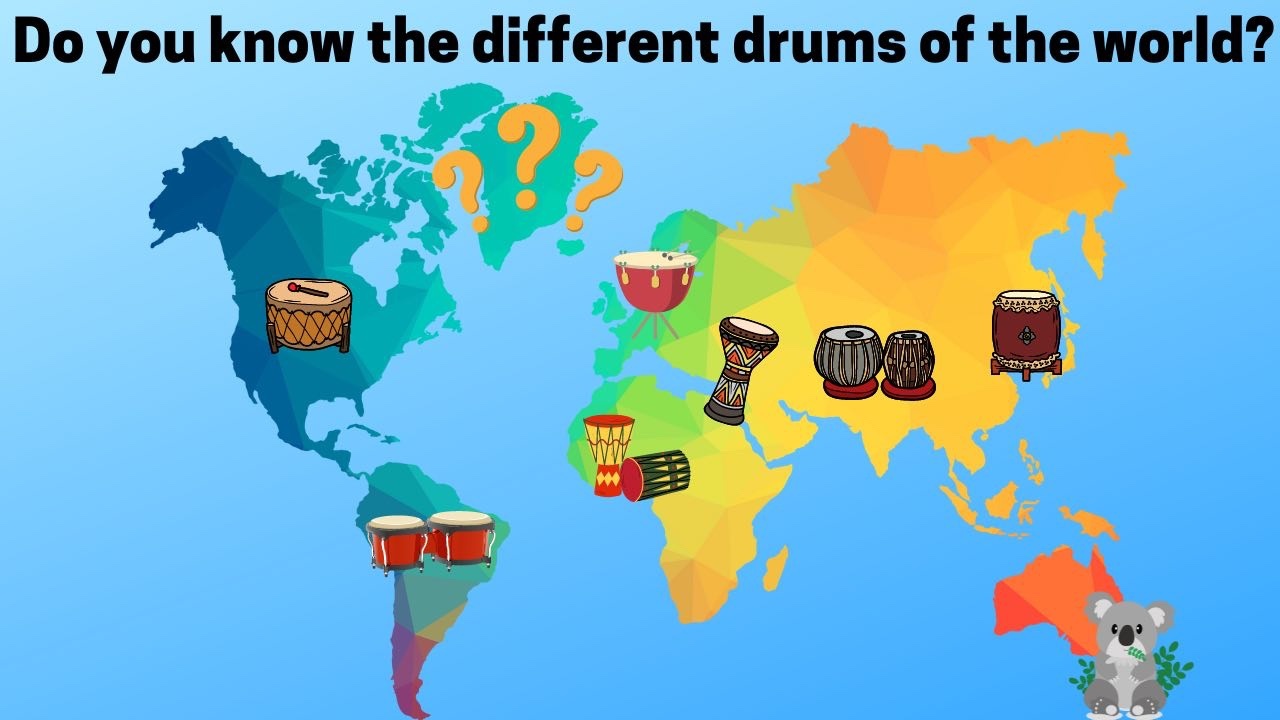
Drums and percussion may be the oldest type of instrument invented by humans. And it seems like just about every culture on every continent has its own approach to drum tones.
That’s why I’ve put together this guide to help teach you what are the different types of drums and percussion in the world.
It covers everything from a standard rock drum kit to Japanese Taiko to Indian Tablas. So if you’re trying to figure out what a certain type of drum is called, you’re in the right place!
Also, if you're looking for a gift for a drummer, check out this drummer gift guide!
The article is organized as follows:
- Acoustic Drum Kit
- Orchestral Drums
- Marching Band Drums
- Afro-Cuban Drums and Percussion
- Indian Drums
- Middle Eastern Drums
- Native American Drums
- African Drums
- East Asian Drums
The drums that make up an acoustic drum kit
The traditional drum kit is probably what most people are familiar with. It includes anywhere from three drums to dozens, depending on the player’s preferences and style. A drum kit is set up in a way that single drummer can play all of the drums at once. Of course, there are many different approaches to how to choose acoustic drum sets, from the size of the drums to their quantity. Moreover different drums are made from different materials, from wood to plastic to metal, each lending their own tone.
Just about every genre of popular music these days includes drums based on acoustic drum kits or electronic drum kits. At the turn of the 20th century, drum kits were a novelty. But over that past century, Western music has come to fully embrace the use of drum kits and the powerful back beats they provide.
Most modern drums prefer to play with solid drum sticks. However, many jazz and folk drummers prefer to play the drums with drum sticks that end in brushes for a softer sound.
Other options include padded mallets for an almost orchestral vibe. I’ve also seen drummers use maracas as drum sticks to add an additional bit of rhythm.
Finally, for the indecisive drummer, there is also the option of playing with multi-rods. These are tight bundles of a bunch of smaller sticks. They sound halfway between classic sticks and brushes.
Kick drum or Bass Drum
The kick drum or bass drum is probably the most famous of the drums. It sits on the floor in the middle of the drum kit and creates a low, punchy sound. The drummer plays the kick drum with a foot pedal that ends in a beater. This is called the bass drum pedal.
Kick drums come in a huge range of sizes. The smallest sized kick drums are just 14” wide, while the biggest are 22” or larger. The bigger the drum, the lower the pitch of the sound.
And the harder it is to load into a car for a gig.
Snare Drum
The snare drum is also an iconic part of the drum kit’s sound. Based on military drums from centuries past, the snare drum is notable for its loud cracking sound. Snare drums feature a wire along the bottom of the drum that helps create the rolling tone they’re known for.
The snare drum and kick drum provides the foundation for modern drum beats. The snare is the source of the “back beat.”
Snares are highly responsive to how they’re played, able to sound bright, dull, sharp or fat.
Floor Tom
The floor tom is the second lowest drum in a drum kit (after the kick drum). It usually has its own set of legs and stands to the right of the kick drum. It has low, dull thud to its tone.
The floor tom is often used in breakdown sections of songs or for drum fills.
Rack tom
A rack tom is a smaller version of the floor tom. Consequently, rack toms have a higher pitch than floor toms, and can some times be tuned to sound fairly tight.
Rack toms are typically mounted on top of the bass drum. The typical drum kit will have one or two rack toms, but some drums may have four, five, or more. A generally for toms, and all drums, really, is that a smaller drum is higher pitched than a larger drum.
Hi hat
A hi hat is a pair of small cymbals on a foot-controlled stand.
The drummer can use their foot to open and close the hi hat. Opening and closing the hi hat with the foot creates a rhythm by itself, but it also changes the tone of the hi hats when played with sticks. A closed hi hat sounds duller, sharper, and shorter than an open hi hat.
As a song builds in intensity, a drummer may slowly open the hi hat for a more intense sound.
The hi hat is usually directly to the right of the snare drum.
Crash cymbal
Most drum kits include one or two crash cymbals. This are large, bright sounding cymbals that really help accent certain parts of the song. They tend not to be used directly as part of the beat (unlike the ride), but are instead uses for fills.

China
A china is a specialized type of crash cymbal with a more explosive tone.
Splash
A splash is also a specialized type of crash cymbal, but they tend to be much smaller and brighter. Most drummers I know with don’t use a splash, but they are still used by lots of drummers.
When it, it really does sound like a splash. Often you see splash mounted upside on top of a crash cymbal, allowing the drummer to quickly hit both creating an exciting contrast.
Ride cymbal
The ride cymbal is usually the biggest cymbal in the drum kit. The ride usually sits to the drummer’s far right.
A ride is less bright than a crash and sustains for longer. A ride often forms the foundation of a beat, being played in eight or quarter notes.
A drummer can also hit the “bell” or top part of the ride cymbal for a much brighter and punchier tone.
Electronic Drums
In recent decades, electronic drums have becoming increasingly popular. Generally, these replicate the same layout and tones as an acoustic drum set. But can also load up different sounds or samples for even wider variety. If you play electronic music or don't want to make a lot of noise while practicing, electric drums can be a great choice.
What are the different types of drums in a classical orchestra?
Classical orchestras make extensive use of drums and percussion. Even going so far as to fire a cannon for dramatic effect.
That said, most orchestral percussion is more traditional, and similar to what you’d see on a drum kit. However, the way percussion is used in classical music is much less about keeping tempo, and much more about highlighting key moments.
Timpani
Timpani may be the most iconic drums in an orchestra. A timpani is a very large drum, tuned to a distinct pitch. Orchestras will typically have few differently tune timpani.
The massive drums in “Thus Spoke Zarathustra,” the theme song for 2001 A Space Odyssey is probably the most famous use of timpani.
Orchestral cymbal
An orchestral cymbal is a lot like a regular drum cymbal, just bigger and louder. Typically they are also used to accent important moments.
Gong
A gong is a massive mounted cymbal that is typically struck with a mallet. It has less sizzle compared to an orchestral cymbal and features more of a bell-type sound.
Crotales
Speaking of bells, crotales a form of small, pitched cymbals. Generally, there are dozen crotales (one for each note of the scale). They allow for very musical sections while still adding percussive interest.
Bell tree
Speaking even more of bells, a bell tree resembles a large wind chime. It features dozens of tuned hollow metal tubes hanging from strings. Unlike a wind chime, though, the percussionist will manually trigger the bell tree, usually by sliding their fingers or a stick across it. Bell trees have a mellow, high pitch that is nothing, but also somewhat random as the various tubes hit each other.
Bell trees have a beautiful, soothing sound. They are often used for transitions between sections.
Triangle
You probably played a triangle in pre-school, right? Well the orchestral percussion version is the same thing, just a little higher quality. Triangles are frequently used to keep time in an orchestra.
Taiko
We’ll talk about Taikos more when we get to East Asian drums. But essential, these are massive, powerful drums played with thick sticks.
Frequently heard in epic cinematic music, Taikos feel very much like war drums. This is an instance of Western cultures adopting an instrument from Japan and incorporating it.
Boobams
Boobams are large hollow cylinders with a taught membrane (or drum head) stretched across one side. A boobam set typically covers one or two octaves, though some cover three. Essentially, it sounds like tuned bongos, but gives a price control over the pitch.
Sand paper
Yep. Sand paper.
For this two work, two strips of sand paper are mounted to handles. The percussionist holds one in each hand, then rubs them against each other. This creates a scratching sound, somewhat similar to shaker.
What are the different types of drums in a marching band?
You can think of a marching band as a deconstructed drum kit (though historically things evolved the other way. Essentially, a marching band consists of dozens of drummers each playing one instrument from the standard drum kit. Collectively, it combines to sound full and complete.
Generally speak, band drums are much larger than those you’d see in a drum kit. They also have to be strapped to the musicians as the march around, which makes some of the playing techniques very different from a classic drum kit.
Snare drum
Drummers will strap the snare drum right around belly button level and play it with two drum sticks. Typically in a marching band, the snares drums provide not only the back beat, but also a lot more drum rolls than you’d find in most popular music.
Some marching bands may also include piccolo snares, which are smaller (and higher pitched).
Bass drum
A bass drum in a marching band plays a similar role to that in a rock band. It is strapped to the drummers’ front, with the two drum heads facing left and right.
Instead of using a kick pedal, though, the marching band drummer hits the bass drum with sticks. They hold one in each hand, and typically alternate sides.
Cymbal
If having a massive bass drum strapped to you makes you feel claustrophobic, cymbals might be a better choice. Marching band cymbals are large, and feature handles on the bells.
Instead of striking the cymbals with a drum stick, a marching band cymbal player will hold one cymbal in each hand and smash them together.
Kind of like those wind up monkey toys.
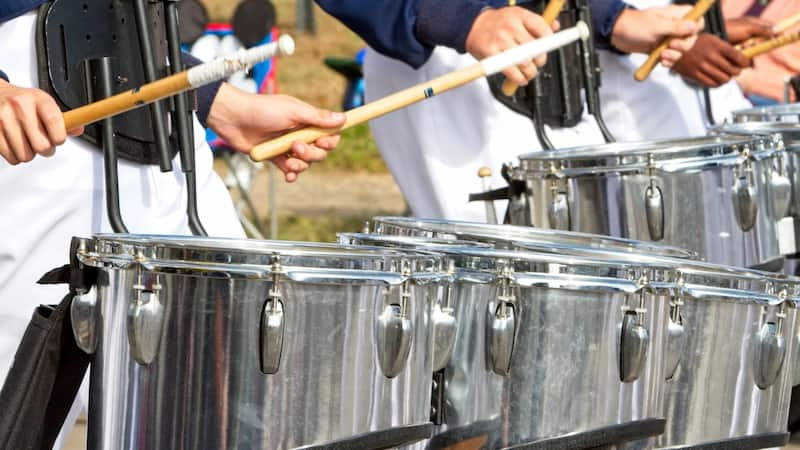
Toms
Marching bands are renowned for busy, rolling tom fills. Drummers cary their tom rack strapped to their waist. They typically have 4 tom drums, which are struck with drum sticks.
Again, drum rolls feature fairly prominently in marching bands.
What are the different types of drums in Afro-Cuban Percussion
Afro cuban rhythms form the framework for most modern music. There is a wealthy of fun and exciting instruments used in Afro-Cuban percussion.
A lot of these Afro-Cuban drums, like the bongos, have also been adopted into modern music.
Conga
Think of the conga as the bongos big brother.
The conga is a large, hollow drum, about 3 feet tall. It has deeper tone than the bongo, and is often played in conjunction with a bongo. Usually there will be a set of two or three congas of different sizes and pitches.
Conga drums are frequently held in the air on a rack, but can also be supported between ones legs.
In smaller Afro-Cuban ensembles, it may play a simpler pattern while the bongos and timbales provide more fills and excitement. However, it can also be the only percussive instrument accompanying melodic instruments like guitars and pianos. In which case it may play a busier pattern.
Bongos
Bongos are pair of small drums that you hold between your legs. The bongos have a bright, light sound that is incredibly pleasant.
From simple rhythms to accompany singer-songwriters to full on blitzes, bongos can play a diverse role in lots of different styles of music.
Guiro
Guiros are totally unique and awesome latin percussion instruments.
Typically they are made from a hollowed gourd about the size of a 1L soda bottle. The top of the guiro features dozens of small ridges.

The player drags a stick across the ridges creating an iconic croaking sound that totally brings the back beat to life. They also typically will hit the stick on the guiro to get a more percussive “plink”, which they then combine with the croak for great grooves.
Timbale
When I took an afro cuban percussion class, the timbale was always my favorite instrument to play.
It consists of two metal drums mounted on a stand (and usually there will be a cowbell in the middle. The percussionist plays the timbales with sticks.
A timbale sounds a lot like a snare, but with out the rattle that the wire brings to a snare. They are bright, punchy, and have a resonant ring to them.
Typically, the timbale won’t play the foundational rhythms, but will be used to accent and add interest and fills on top of the groove.
Caixixi
A caixixi is a unique form of shaker with a beautiful smooth and round tone. Traditionally these instruments are made from woven reeds (like a basket) and filled with seeds. They usually have one end that is covered in a thin slice of gourd to provide a brighter sound.
Maracas
Maracas are another type of shaker that is held in the hands and… shook. Maracas traditionally are made from hollowed out gourds full of seeds or pebbles. They provided a consistent rhythmic backdrop for beats in varied genres.
Woodblock
Simple and straight forward, woodblocks are, claves, and cowbells are essential time keeping tools in Afro-Cuban percussion. Usually they will be used to keep a consistent time (like straight quarter notes) while other instruments are playing the 3-2 or 2-3 clave patterns.
Woodblocks traditionally are hollowed out wooden rectangles that are hit with a stick. They have a mellow, resonant ring to them that fits in well across many styles.
Clave
Claves are two round, solid wooden sticks that you hit together. They create a bright, mellow tone that is also used for time keeping. Typically though, the clave pattern is busier than the woodblock pattern.
Clave are also used in all sorts of other genres.
Cowbell
If you have a fever, then you probably need some cowbell.
Or if you’re playing almost any style of music.
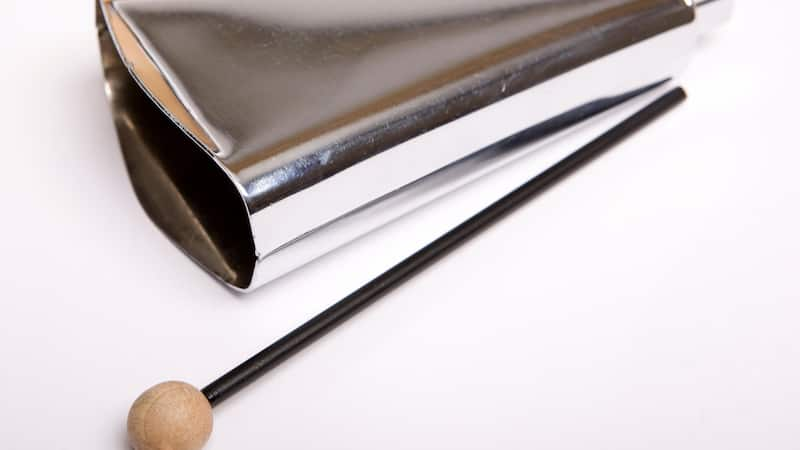
Cowbells are hand sized metal bells that you strike with a drum stick. They feature a very bright, short, sharp sound that varies in pitch depending on where you strike the cowbell.
Sometimes cowbells are just used to keep basic time, but there are also plenty of amazing cowbell solos out there!
Cajon
What’s in the box? Nothing!
A cajon is a big, hollow box that the percussionist sits on and slaps with their hands. It tends to have a very low pitched sound, and tends to play the role of the kick drum in afro-cuban percussion.
Lately that cajon has been seeing increased popularity with folk musicians who appreciate its simplicity and portability.
What are the different types of drums in Indian Music?
Indian music is famous for its use of unique pitch modulation of drum tones, coupled with amazing rhythmic patterns. These drums are the main percussion instruments found in Indian music, but with such a vast landscape and ancient history, there are plenty of other instruments out there.
Tabla
Played as a set of two hand drums of different size. The big drum has a distinctive pitched sound, which is frequently moved up and down by the player creating a beautiful groove. The tabla is perhaps the most famous Indian drum in the west. Checkout this amazing demonstration of a solo tabla!
Chenda
A Chenda is a fairly large percussive drum. While there are regional variations in size and shape (with different pitches), the most common version is approximately 2 feet long and half as wide. The cylinder is covered on both ends with a taught skin, and the drummer beats the top skin with two sticks. Because the drum is worn suspended around the neck, it is particularly notable for how loud it is, because there is not much to dampen its sound.
Mridangam
Like many of the Indian instruments, the Mridangam is a double-sided drum, with animal skin heads on both ends. Usually it is played while seated. The drum rests horizontally on the players lap. It is played with the fingers and palms. The fingers of one hand usually plays a busy, syncopated rhythm on the right side of the drum which has a percussive “plingy” sound. The other hand plays a duller-toned, more consistent rhythm on the left side of the drum, usually with the flat of the hand.
Kanjira
The a frame drum with loose, with a couple of loose metallic pieces attach that can jingle. It is fairly similar to a tambourine, though typically thicker with a smaller diameter.
Dhadd
The Dhadd is an hourglass-shaped traditional Indian musical instrument for percussion, originally from the Punjab region. It features a skin head on either end, held together and tuned via a series of ropes. The player strikes one end of the Dhadd with their fingers, and the pitch of the drum can be manipulate by squeezing the ropes that run the drum’s length.
Dhol
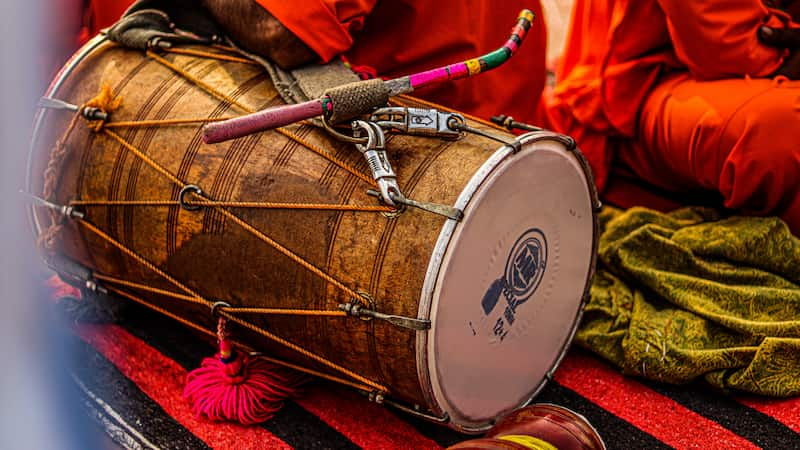
The Dhol is one of the larger Indian drums used in percussion. It is the size and shape of a small barrel. Each end features skins, tightened by rope. Notably the thickness of the skin on each end is different, with the thicker end providing bass-ier notes. They are usually slung across the body diagonally, allows access to both sides of the drum. The player then uses a wooden stick in each hand to play the Dhol.
Dholak
A Dholak is essentially a smaller version of the dhol.
Ghatam
The ghatam is much different than any of the other Indian percussion instruments discussed so far. It is one of the oldest percussion instruments in Indian history. Instead of being a wooden drum with skins, the Ghatam is a clay pot with a narrow mouth. It is mainly made from clay baked with brass or copper filings with a small amount of iron filings. The pitch of the ghatam depends on its size. The player places the pot on their lap, and strikes it with their palm and fingers. Because the pot is curved, striking it in different areas produces different tones.
Phakawaj
A lower pitched version of the Mrindangam.
Dhak
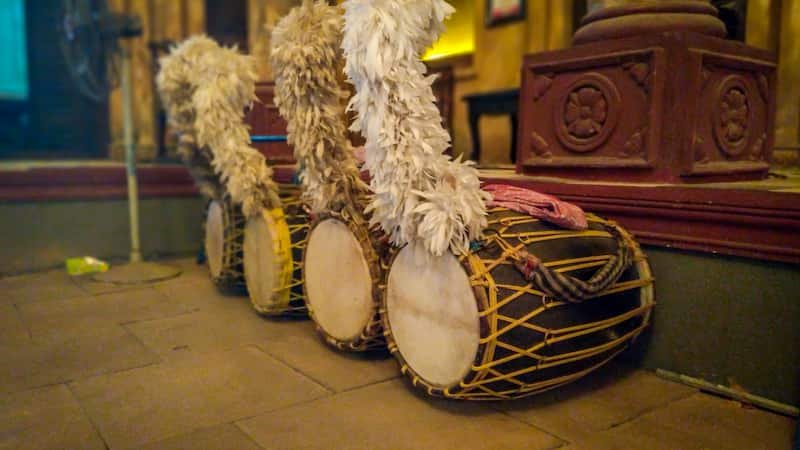
A Dhak is perhaps the biggest of the Indian drums. It is essentially a barrel with skins on each side, played with drum sticks.
Khol
Like the ghatam, the khol is a clay pot used for percussion in traditional Indian music. However, Unlike the ghatam, the khol is a two-sided drum that features skins on each side tied together. One side is smaller and produces a metallic sound, while the wider side produces a lower, bass sound. It is played directly with the hands.
What are the different types of drums used in Middle Eastern Music?
Middle Eastern percussion instruments are somewhat of a hybrid between Western percussion and Indian percussion. The drums of the Middle East tend to be a bit more “plingy” and high pitched compared to Western percussion, and tend to use bells/cymbals more than Indian percussion. Here are some of the most popular.
Like Indian percussion, there is a wide variety of regional variation in Middle Eastern percussion. In some places the drums may be slightly bigger or smaller, or played in a different style. They also have different names in different regions.
(Metal) Doumbek (also known as Derbake, Darbuka, Doumbek, Tarabuka, Tumbak and Tarabaki)
A doumbek (also known as a goblet drum) is a drum shaped like a goblet! No surprise there with a name like that.
The wide end features a skin, while the narrow bottom is uncovered. Traditional they were made from wood, but metal versions, with a brighter tone, are also popular. Typically these drums are held under the armpit or on the lap, and played with a fast and light finger tapping technique.
Dahola
The dahola is essentially a larger version of the doumbek. Consequently it can produce much deeper tones, producing a bass drum like quality.
Davul
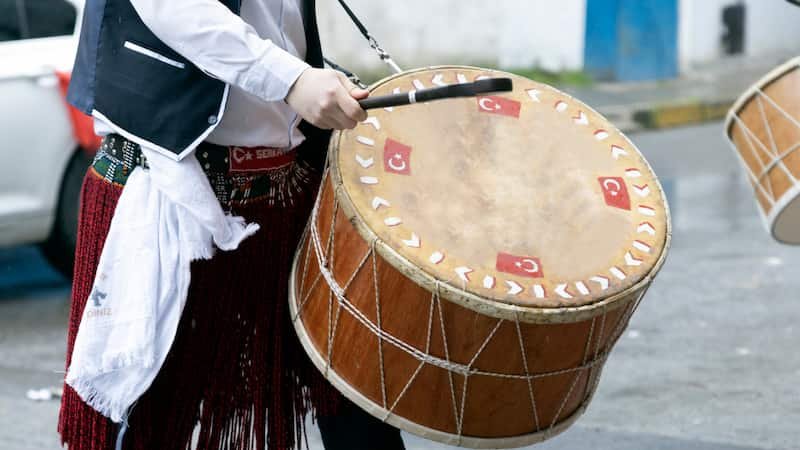
A large double headed circular drum that is played with sticks. This drum is similar to the Indian dhol, and produces a powerful, low sound.
Katem
A large, circular frame drum, like a tambourine, without jingles. Despite its large circumference, it still makes a relatively high pitched sound due to the tautness of its drum head and thin rim.
Kodum
A pair of differently pitched kettle drums, frequently associated with Turkey. They have skins across the top head, with a body made of metal and are shaped like a half sphere. The percussionist plays them with wooden sticks. They are about 9 inches wide (28-30 CM) and 6 inches high (16CM).
Rik / Daf / Duff / Tef / Def
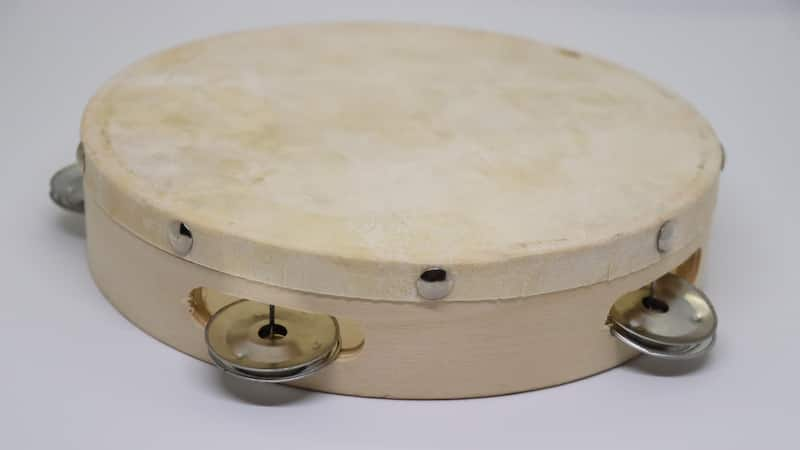
The Rik (aka Daf, Duff, Ted, Def) is a frame drum, not too dissimilar from a tambourine. It is a thin circular drum with a skin stretched on one side. However, it is much wider than a tambourine, with a diameter of 18-20 inches (45-50 CM). Like a tambourine, it features small cymbals along its rim. It is most commonly associated with Iran and Pakistan.
Zil
A pair of cymbals worn on the fingers. Zil are frequently used by dancers, but also serve to add energy and excitement to Middle Eastern music.
What are the different types of drums used in Native American Indian music?
Native American percussion instruments play a key ceremonial role in Native American life. Often associated with religious ceremonies, dancing and gathering, many of these instruments are intended to be used while dancing.
Pow wow Drum
A large circular drum with skin heads on top and bottom sides. They are 2-3 feet in diameter (almost 1 meter). Pow wow drums sit on a wooden cradle and is played with mallets. These drums are considered sacred and are typically played ceremonially by many people at once.
Hide frame hand drum
Like many cultures through out the world, the Native American frame drums are similar in size and shape to a tambourine, though perhaps a bit larger. They lack any jingles, and are typically played with a beater.
Water Drum
Water drums are a very unique Native American percussion instrument. Typically made from clay pots, water drums would then be filled with water until they reached the desired pitch. From there, a skin would be tightened over the top of the water drum, providing a pitched sound.
Rattle
Intricately carved rattles, such as the raven rattle, are also common throughout Native American music. These rattles typically include hallowed out gourds filled with stones, seeds, or other hard, little objects.
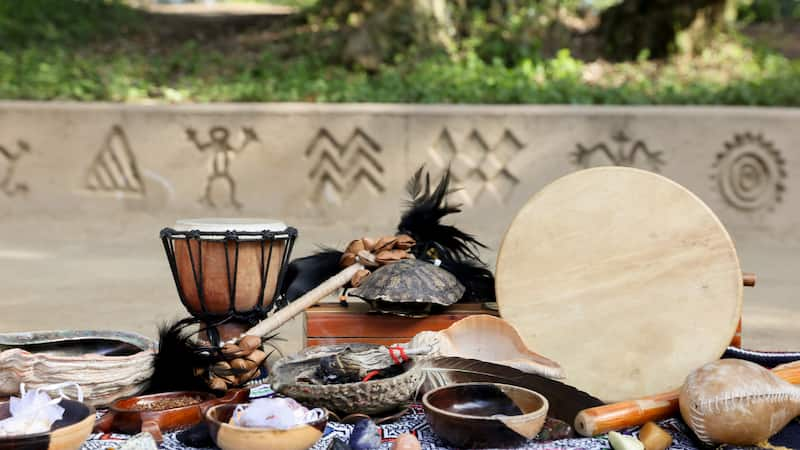
Dance Wands
Dance wands are sticks held by dancers that are perhaps a foot and a half long. They are covered with dangling, hard objects, somewhat like a wind chime. These could be animal bone, metal, hooves, etc. When a dancer moves, the wands rattle in time.
Ankle rattle
Ankle rattles provide a similar effect, providing a percussive shake every time the dancer moves. These ankle rattles consist of straps wrapped around the ankles, covered in loose shells, gourds, metal bells or other objects that rattle in time to the dancer’s movement.
What are the different types of drums in African music?
African music is full of intriguing types of drums, drawing from different cultures from West Africa to the far south. For the purposes of this article on African drums, I haven't written about all of the amazing melodic percussion in African music like marimbas, but they are also arguably part of this story.
Djembe
The djembe is perhaps the most popular of African percussion instruments, and there are few college dorms that don’t have some of these lying around. The djembe is another of the goblet drums, featuring a skin on the wide top and an open narrow bottom. Typically it is played with bare hands. It is a fairly loud drum, capable of producing a wide variety of pleasant tones.
Dunun
A dunun is some what like a marching band tom tom. It is cylindrical, features a skin at both ends that are tuned by rope, and is played with sticks. The dunun can be cared on the body with a strap. That said there are a wide variety of sizes and approaches to the dunun through such a vast region.
Ankle Bells
Much like in Native American cultures, many African cultures use bnkle bells
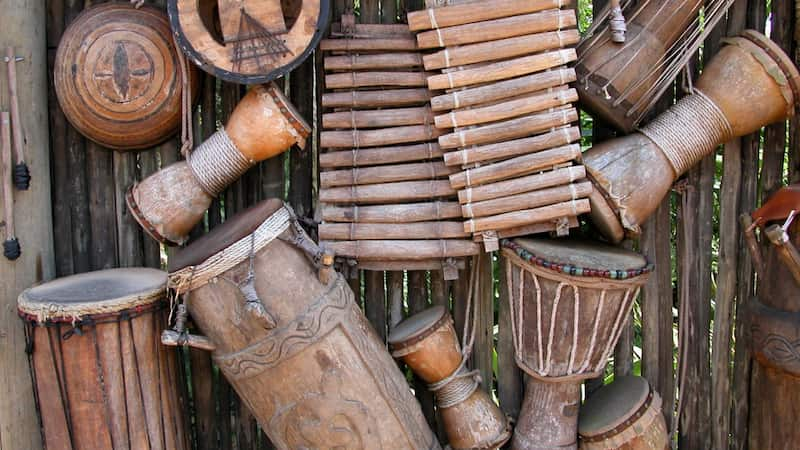
Krin
The krin is a hollowed out log drum, played with mallets. Essentially, a long (3-4 foot) log is almost completely hollowed out, with various bars left intact that can be struck to produce different pitches. Krins were used not only for long distance communication, but for different village ceremonies.
Calabash
Calabash drums are made from a round, large, hollowed out gourds. The top of the gourd is then covered in a skin, which is tuned with a series of ropes. They can be slung over the shoulder and are played by hand.
What are the different types of drums in East Asian Music?
East Asian percussion focuses on big drums, bright cymbals, and sharp, percussive hits. From gongs to taikos, these may be some of the most dramatic types of drums in the world!
Bangu
The bangs is a wooden Chinese drum approximately 25 cm (10 inches) in wide at the top and 10 cm (4 inches) tall. It has a skin on the wide top side which is struck with thin bamboo sticks and produces a sharp, thin sound. The entire drum hangs on a stand so that it is free to reverberate.
Paiban
Paiban are essentially wooden clappers, though the sound is much sharper than a claver. Frequently paiban are made from pieces of bamboo tied together, and are used for the characteristic time counting frequently seen in various forms of Chinese Opera.
Dabo
Dabo are a pair of large, hand-held cymbals that can be struck together to create a variety of powerful tones. They are loud, bright, and played by tying rope loops through them as hand holds.
Naobo
Naobo are just a smaller, brighter version of Dabo. Da 大 is Chinese for big (I majored in Chinese in college, but have no idea what nao or bo mean).
Daluo

Daluo (remember - Da means big) is a large gong, though it’s still small enough to be held by hand with a handle. Known for a powerful, but smooth attack and a mellow, falling decay, daluo are played with a soft mallet.
Xiaoluo
A xialuo is a small gong (Xiao 小 means small). It has a brighter tone than its larger cousin.
Hua Penggu
The Hua Peng Gu is barrel-shaped drums. It features a skin stretched taut on both ends. It has a powerful tone, with two main sounds — low when hit in the middle of the drum head, and mid when hit on the wooden shell or rim of the drum head.
Xiao Tanggu
The Xiao Tanggu is essentially just a smaller version of the Hua Penggu, with a warmer, more mid-range tone.
Kane
The Kane is a Japanese small bell. It is usually held by hand suspend by a rope, but can also be hung from a frame. It produces a bright tone and can make three different types of sounds depending on where and how it is struck by a pair of mallets.
Kakko
The kakko is a smaller cylindrical drum mounted horizontally on two curved wood blocks. Skins are affixed to each end of this wooden drum and made taught with rope. The player uses thin mallets to strike each side. It has a relatively high, sharp sound for a drum, with very woody tones.
Ko Tsuzumi & O Tsuzumi
The Tsuzumi style of drums are small, hour-glass shaped wooden drums. They have skins on each end, which are made taught by a series of ropes running up and down the drum. The player carries the drum in one hand, striking it with their hand. The hand that holds the drum squeezes the ropes to adjust the pitch of the drum, which is capable of creating a wide variety of raising and falling tones. The Ko Tsunami is the smaller of the too.
Taiko or Daiko
Taiko are large, barrel shaped drums, usually mounted on wooden stands and exquisitely lacquered. They come in a variety of sizes, but are all large. They are played by striking them with large wooden sticks called nacho, producing a deep, sharp striking sound.
Shoko
The shook is a small Japanese gong that is often beautifully decorated and mounted. It is struck with mallets. However, the playing style involves leaving the mallets on the gong after striking, effectively muting it. This creates, short, deep blasts.
Jing
A Jing is a sizable Korean gong, suspended from a wood frame that is played using a padded mallet. The playing style for the Korean Jing is the opposite of the Japanese Shoko, with the intention being to let the gong resonate as long as possible.
Kkwaeggwari
The Kkwaenggwari is a small, bright hand-held gong. One hand uses a mallet to strike the gong in different places creating a range of textures, while the hand that holds it can also be used to mute the drum changing the tone, texture and rhythm.
Samul-Buk & Sori-Buk
A Buk is a two-headed barrel drum covered with skins. On the Samul-buk the skins are made taught by rope, and it is played with a mallet. However only one of the heads is struck.
In contrast, with Sori-bukplayed one skin is played with an open hand and the other head is played with a stick.
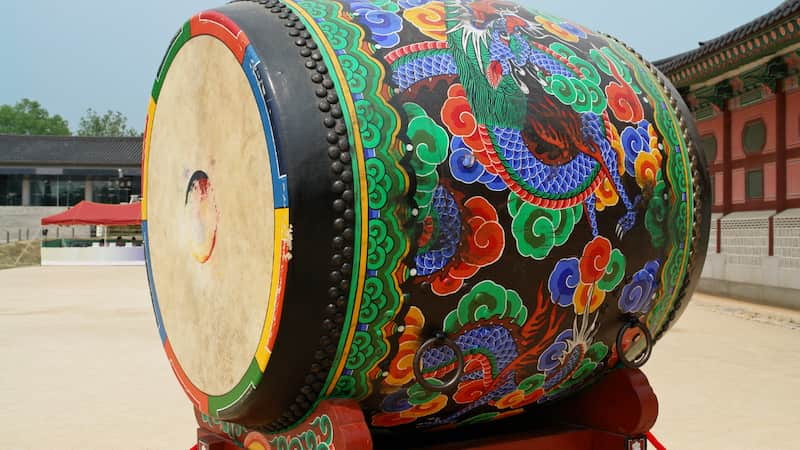
This contrast in tone creates myriad rhythmic opportunities. The skins of the Sori-Buk are also nailed to the drum, unlike the Samul-Buk.
Samul Janggu & Sanjo janggu
The Janggu style of drum are wooden hour-glass shaped drums with skins on each end held together by ropes. Each drum head produces a different tone. The drum is typically slung across the front of the body and played with a thin mallet to strike the high-pitched head, and the bare hand to strike the low pitch hand. The Samul Janggu is the smaller, brighter version of these drums.
Concluding Thoughts about the Different Types of Drums of the World
It's amazing how universal drums are in ever world culture. There are amazing commonalities among different drums, but also incredibly unique ways of approaching the rhythm, tone, and texture. I've trie to survey all of the world's drums here, but if you feel I've left anything out, please let me know in the comments. Now to leave you with this wonderful summation of lots of different types of percussion by the World Drum Club!
From a Frustrated Producer in a Ragtag Bedroom Studio to Major Placements on TV Earning $1,000s!
My name is Evan, and I've been making music since around 3rd grade. I'm from San Diego, California, but I've lived in Washington, DC for the last 20 years.
While I still have a full-time day job, I have created systems that have allowed me to produce dozens of songs a year in my spare time.
My songs have been on Netflix, TV shows like the 90 Day Fiance, an award-winning indie film, and NPR’s “All Thing Considered.” They've also been streamed millions of times.
In addition to being a music producer, I am passionate about teaching people how they can make professional-sounding music and earn money licensing it, all in their spare time.
Thousands of musicians, like yourself, have trusted me to guide their musical journey. My YouTube videos have been watched nearly a million times. And my story has been in Forbes, Side Hustle Nation, and the Side Hustle School.





